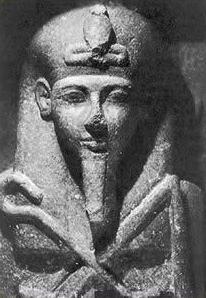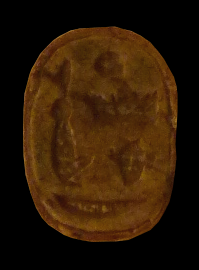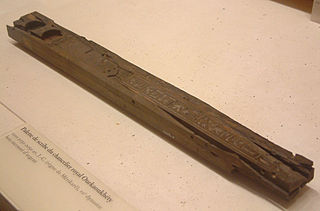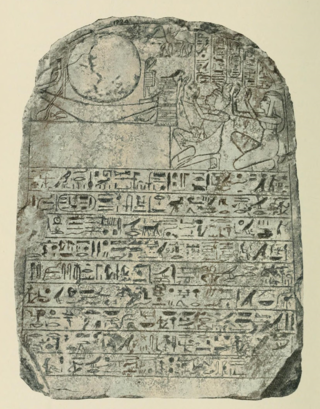Related Research Articles
This article concerns the period 399 BC – 390 BC.

Amenhotep II was the seventh pharaoh of the Eighteenth Dynasty of Egypt. He inherited a vast kingdom from his father Thutmose III, and held it by means of a few military campaigns in Syria; however, he fought much less than his father, and his reign saw the effective cessation of hostilities between Egypt and Mitanni, the major kingdoms vying for power in Syria. His reign is usually dated from 1427 to 1401 BC. His consort was Tiaa, who was barred from any prestige until Amenhotep's son, Thutmose IV, came into power.

Amenmesse was the fifth pharaoh of the Nineteenth Dynasty in Ancient Egypt, possibly the son of Merneptah and Queen Takhat. Others consider him to be one of the innumerable sons of Ramesses II. Very little is known about this pharaoh, who ruled Egypt for only three to four years. Various Egyptologists date his reign between 1202 BC–1199 BC or 1203 BC–1200 BC with others giving an accession date of 1200 BC. Amenmesse means "born of or fashioned by Amun" in Egyptian. Additionally, his nomen can be found with the epithet Heqa-waset, which means "Ruler of Thebes". His royal name was Menmire Setepenre.

Akhenre Setepenre Siptah or Merneptah Siptah was the penultimate ruler of the Nineteenth Dynasty of Egypt. His father's identity is currently unknown. Both Seti II and Amenmesse have been suggested although the fact that Siptah later changed his royal name or nomen to Merneptah Siptah after his Year 2 suggests rather that his father was Merneptah. If correct, this would make Siptah and Seti II half-brothers since both of them were sons of Merneptah.

Amyrtaeusof Sais is the only pharaoh of the Twenty-eighth Dynasty of Egypt and is thought to be related to the royal family of the Twenty-sixth Dynasty. He ended the first Persian occupation of Egypt and reigned from 404 BC to 399 BC. Amyrtaeus' successful insurrection inaugurated Egypt's last significant phase of independence under native sovereigns, which lasted for about 60 years until the Persians conquered the country again.

Nectanebo I was an ancient Egyptian pharaoh, founder of the last native dynasty of Egypt, the 30th.
Tutkheperre Shoshenq or Shoshenq IIb is an obscure Third Intermediate Period ancient Egyptian pharaoh whose existence was, until recently, doubted. In 2004, a GM 203 German article by Eva R. Lange on a newly discovered stone block decoration from the Temple of Bubastis that bore his rare royal prenomen, Tutkheperre, confirmed his existence because his name is found in Lower and Upper Egypt. Tutkheperre's prenomen translates approximately as "Appearance of the Image of Re."

Tefnakht II was an ancient Egyptian ruler of the city of Sais during the early 7th century BC. He is recognized as an early member of the so-called "Proto-Saite Dynasty", which directly preceded the 26th Dynasty of Egypt.
Nepherites II or Nefaarud II was the last pharaoh of the feeble and short-lived Twenty-ninth Dynasty, the penultimate native dynasty of Egypt.

Hakor or Hagar, also known by the hellenized forms Achoris or Hakoris, was an ancient Egyptian pharaoh of the 29th Dynasty. His reign marks the apex of this feeble and short-lived dynasty, having ruled for 13 years – more than half of its entire duration.
Psammuthes or Psammuthis, was a pharaoh of the Twenty-ninth Dynasty of Egypt during 392/1 BC.

Nefaarud I or Nayfaurud I, better known with his hellenised name Nepherites I, was an ancient Egyptian pharaoh, the founder of the 29th Dynasty in 399 BC.

Nimlot C was a High Priest of Amun at Thebes during the reign of pharaoh Osorkon II of the 22nd Dynasty.

Merikare was an ancient Egyptian pharaoh of the 10th Dynasty who lived toward the end of the First Intermediate Period.
Purportedly inspired by the teaching of his father, he embarked on a semi-peaceful coexistence policy with his southern rivals of the 11th Dynasty, focusing on improving the prosperity of his realm centered on Herakleopolis instead of waging an open war with Thebes. His policy was not rewarded, and shortly after his death his kingdom was conquered by the Theban Mentuhotep II, marking the beginning of the Middle Kingdom. The existence of his pyramid has historically been ascertained, although it has not yet been discovered.
Thamphthis is the hellenized name of an ancient Egyptian ruler (pharaoh) of the 4th Dynasty in the Old Kingdom, who may have ruled under the name Djedefptah for between two and nine years. His original Egyptian name is lost, but it may have been Djedefptah or Ptahdjedef according to William C. Hayes. Thamphthis is one of the shadowy rulers of the Old Kingdom, since he is completely unattested in contemporary sources. For this reason, his historical figure is discussed intensely by historians and Egyptologists.

The Twenty-ninth Dynasty of Egypt is usually classified as the fourth Dynasty of the Ancient Egyptian Late Period. It was founded after the overthrow of Amyrtaeus, the only Pharaoh of the 28th Dynasty, by Nefaarud I in 398 BC, and disestablished upon the overthrow of Nefaarud II in 380 BC.
Ammeris was a governor of Sais attributed to the so-called "Proto-Saite Dynasty" of ancient Egypt.

Iuwelot or Iuwlot was a High Priest of Amun at Thebes and military commander during the reign of pharaohs Osorkon I and Takelot I of the 22nd Dynasty.

Smendes III was a High Priest of Amun at Thebes during the reign of pharaoh Takelot I of the 22nd Dynasty.
The Demotic Chronicle is an ancient Egyptian prophetic text. The work is intended to provide a chronicle of the 28th, 29th and 30th dynasties – thus the independence interval between the two Persian dominations. Rather than providing historical events occurred during the reigns of the pharaohs of the aforementioned period, the Demotic Chronicle judges these rulers on the basis of their behaviour, explaining the length and prosperity of their reigns as an expression of divine will. The Chronicle also emphasizes the misrule of the "Medes" and of the Ptolemies, and prophesies the coming of a native hero who will ascend to the throne and restore an era of order and justice upon Egypt.
References
- ↑ Nicolas Grimal, A History of Ancient Egypt, Blackwell Books, 1992.
- ↑ Ray, op. cit., p. 155.
- ↑ Ray, op. cit., p. 152.
- ↑ Ray, op. cit., p. 158.